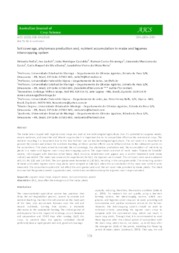Soil coverage, phytomass production and, nutrient accumulation in maize and legumes intercropping system.
Soil coverage, phytomass production and, nutrient accumulation in maize and legumes intercropping system.
Autoria: NOLLA, A.; JUCKSH, I.; CASTALDO, J. H.; ALVARENGA, R. C.; COSTA, L. M. da; DAMY, C. R. da S.; MOTA NETO, L. V. da
Resumo: The maize intercropped with legume cover crops are used at low technological agriculture, due it?s potential to suppress weeds, recycle nutrients, and cover the soil. Weeds suppression it is important due to its competition effect on the commercial crops. The nutrient recycling it is important due to the low fertilizer use on low technological agriculture. The soil cover it is important to prevent the erosion and reduce the nutrients leaching. All those positive effects can be influenced due to the cultivated species on the consortium. This study aimed to evaluate the soil coverage, the phytomass production and, the accumulation of nutrients by plants in a maize and legume cover crops intercropping system. The experiment consisted of rustic maize ?Caiano de Sobrália? variety, intercropped with Brazilian velvet bean, black mucuna, lablab-bean and pigeon pea; a control treatment (sole maize culture) was added. The maize was sown on the experiment; 64 DAE, the legumes were sowed. The soil cover rates were evaluated at 0, 64, 84, 120, and 144 DAE. The corn grains were harvested at 120 DAE, resulting in the corn grain yields. The remaining portion of maize and entire legume cover crop plants were sampled at 144 DAE, when the accumulation of dry mass and nutrient were measured. The consortium system did not affect the corn grains yield and, the soil cover rate provided by maize plants. The black mucuna had the greatest weeds suppression and, nutrient accumulation among the legumes cover crops evaluated.
Ano de publicação: 2019
Tipo de publicação: Artigo de periódico
Unidade: Embrapa Milho e Sorgo
Palavras-chave: Cobertura do Solo, Conservação do Solo, Consorciação de Cultura, Erva Daninha, Leguminosa, Milho, Nutriente, Planta daninha, Planta de Cobertura
Observações
1 - Por padrão são exibidas publicações dos últimos 20 anos. Para encontrar publicações mais antigas, configure o filtro ano de publicação, colocando o ano a partir do qual você deseja encontrar publicações. O filtro está na coluna da esquerda na busca acima.
2 - Para ler algumas publicações da Embrapa (apenas as que estão em formato ePub), é necessário ter, no celular ou computador, um desses softwares gratuitos. Sistemas Android: Google Play Livros; IOS: iBooks; Windows e Linux: software Calibre.
Acesse outras publicações
Acesse a Base de Dados da Pesquisa Agropecuária (BDPA) para consultar o acervo completo das bibliotecas da Embrapa.

